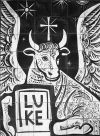
The Passion according to Luke
Agony and Arrest: Lk 22,39-53
The Prayer of Jesus: 22,39-46
In effect, Luke has completely re-written Mark for this time of Jesus' prayer. Lk 22,46 with the comment about temptation or testing is the last line in common with Mark, Mk 14,38. Mk 14,37-42 is omitted completely. This has made for a simpler and more compact scene.
It is only at this point, 22,39, that Luke says Jesus goes to the Mount of Olives. This happens after the exchange about Peter's denials, instead of before as in Mark (Mk 14,26). Furthermore, Jesus arrives at the place (22,40). There is no Gethsemane (Mk 14,32), no garden (Jn 18,1).
For Luke, mountains are where Jesus prayed (6,12 or the transfiguration, 9,28). For this prayer too, Luke has again placed Jesus on a mountain, the Mount of Olives.
Verse 39 sets the scene. Luke says Jesus goes "as his custom was", recalling the end of chapter 21 when he says Jesus went to the Mount of Olives each night (21,37).
"And the disciples followed him" is a comment made only by Luke; following Jesus of course is what disciples do. A contrast is now being set up between Jesus and the disciples. All the disciples are here, not a select group as in Mark (Mk 14,33). This is a general statement; that Judas would have been absent (22,47) does not invalidate Luke's point. This scene at the crucial moment in the life of Jesus becomes a lesson in prayer for disciples of all ages.
Verses 40 and 46 both have Jesus saying "pray not to be put to the test" so there is a bracket around this episode. This echoes the final line of the Lord's prayer (11,4). Testing is better than the traditional rendering "temptation". In 4,1-12, the devil tested Jesus and left him for a time. Now Jesus will be tested again but so too will be the disciples.
The prayer of Jesus in verse 42 is a model of all prayer. Jesus has no wish for his cup, his destiny. He is though in the hands of his Father whose will comes first.
The angel in verse 43 recalls the angel sent to strengthen Elijah (1 K 19,4.7).
"Agony" in verse 44 could be translated "struggle". This fits the metaphor of sweat like great drops of blood.
The disciples asleep would not have heard or seen Jesus at prayer. The same message is given as in verse 40. What is true for Jesus will be true for them pray not to be put to the test.
Back to the main page.
The Arrest of Jesus: 22,47-53
"While he was still speaking" in verse 47 provides continuity. The crowd comes but without any mention of who sent them as in Mark (Mk 14,43).
Luke has then simplified Mark by going straight to Judas's kiss, removing the comments about the kiss as a sign, Mk 14,44. Instead there is the reply of Jesus to Judas in verses 48. Whereas in Matthew (Mt 26,50) Jesus calls Judas "Friend", here he uses Son of Man for himself.
Luke also makes a bit more of the ear incident, with Jesus healing the ear in verse 51.
It is the disciples who take the initiative when they ask about the sword and then quickly follow this up with action. Jesus however heals the servant, another detail unique to Luke.
Finally, in verse 52, we are told that the chief priests and their party are also present which means that Jesus can address them directly. Jesus makes clear their underhand dealings.
"The hour" in verse 53 sounds Johannine. The hour is mentioned several times in that Gospel until the hour finally comes (Jn 13,1).
Unlike Mark and Matthew, Luke does not say that the disciples flee.
We now return to the main page.
